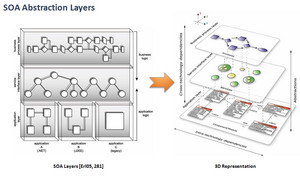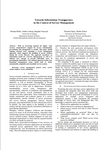Kaleidoscope - Generic SOA Views

Context
Service-oriented architectures (SOA) offer concepts and principles which allow the realization of flexible corporate applications and the implementation of agile system environments. Service-oriented approaches provide the additional advantage that multiple perspectives and points of view within an organization can be taken into account. SOAs feature useful abstractions at different levels. Therefore they are not only comprehensible to IT personnel but also to non-IT personnel. This characteristic of an SOA taps into the knowledge of many employees thus contributing to its success and, incidentally, enables the management of the IT and business departments to gain appropriate influence on the main architectural decisions.
Challenges and Motivation
Due to the fact that the complexity of software is permanently increasing, the development and maintenance of software systems are expensive and time consuming processes. The successful execution of these processes depends predominantly on the extent to which the complexity of the problem domain and the system can be managed. Apart from the great number of advantages IT leaders discover a noticeable increase of complexity when implementing SOA initiatives. This refers to both the problem complexity and the solution complexity of an SOA. Technology, business processes, business functionality, integration and maintenance are elements of complexity which threaten enterprise projects and reduce an enterprise’s agility.
In contrast to stand-alone solutions, which operate as self-contained systems, SOA is a distributed approach. Service-oriented systems do not have clearly defined boundaries. Thus, the governance as well as a comprehensive knowledge and understanding of the system as a whole are essential when services are implemented on different platforms. Additionally, system-wide and domain-exceeding knowledge and understanding are compulsory from the functional point of view. Different stakeholders may have numerous views of a certain system, which contain different aspects and pieces of information in relation to the system as a whole.
![]() The set of relevant views which is used to document a system’s architecture mainly depend on the goals of specific stakeholders. Once documented, those views have a static nature, even though they are subject to change due to iteration cycles. The related set of concerns represented by a specific view will remain the same (otherwise a new view would have been created). But a set of documented views cannot cover the variety of concerns related to a software system arising from different stakeholders acting in a dynamic environment. The stakeholder’s concerns and goals mainly depend on their roles, experiences as well as their knowledge and are influenced by changing requirements. Particularly, SOAs that support a dynamic environment lead to a variety of concerns caused by the additional complexity.
The set of relevant views which is used to document a system’s architecture mainly depend on the goals of specific stakeholders. Once documented, those views have a static nature, even though they are subject to change due to iteration cycles. The related set of concerns represented by a specific view will remain the same (otherwise a new view would have been created). But a set of documented views cannot cover the variety of concerns related to a software system arising from different stakeholders acting in a dynamic environment. The stakeholder’s concerns and goals mainly depend on their roles, experiences as well as their knowledge and are influenced by changing requirements. Particularly, SOAs that support a dynamic environment lead to a variety of concerns caused by the additional complexity.
Hence the use of views should not only support certain phases, e.g. design or construction, but contribute to the whole SOA life cycle and its evolution. Taking this into account, different research questions arise:
- How can a stakeholder consider pieces of information within a certain context, if he does not have access to that information in the form relevant to him?
- How can a stakeholder gather and comprehend information in an efficient manner?
- What are relevant views?
- Who defines which aspects are relevant to a specific stakeholder?
Objectives
- Mastering the complexity of software intensive systems
- Integrate enterprise repositories to support on-demand creation of generic views
- Provision of consistent information in the context of SOA governance
- Efficient provision of context-specific information based on stakeholder profiles
- Analysis and evaluation of SOA design principles
- Better comprehension of the SOA environment
- Three-dimensional generic views
- Navigation and interaction techniques
- Development of prototypes to evaluate conceptual models and software interfaces
- Adaption to real world scenarios
Rescent Results

We developed an approach called the Generic View Concept to facilitate the on-demand and context-specific creation of views of SOA-based systems to fulfill the variety of stakeholder concerns. The Generic View Concept is a holistic approach which is not bound to specific SOA environments, e.g. influenced by the organizational structure, implementation details, infrastructure or strategies. It is not intended to replace other view concepts that have proven to be successful when developing software systems. It is rather a complementing concept focused on comprehension and analysis of information in the context of SOAs. An overview of the Generic View Concept is illustrated in the figure below which shows the core elements. The concept is divided into the four main areas: Information, Profile, Context Creation and Visual Representation.
 To make use of our approach and gather first experiences with a software tool using real data we developed a prototype (see video demonstration above) which is based on the Generic View Concept. Using the prototype stakeholders are able to configure profiles based on their concerns. An extensible dimension system was introduced which allows a flexible configuration and visual transformation. The prototype uses 3D technologies to represent Generic Views as an alternative to 2D representation forms.
To make use of our approach and gather first experiences with a software tool using real data we developed a prototype (see video demonstration above) which is based on the Generic View Concept. Using the prototype stakeholders are able to configure profiles based on their concerns. An extensible dimension system was introduced which allows a flexible configuration and visual transformation. The prototype uses 3D technologies to represent Generic Views as an alternative to 2D representation forms.
Please take a look at our paper references below for further readings.
- Belter, Roman; Spies, Thorsten; Ludwig, Andre; Franczyk, Bogdan; Eicker, Stefan: Towards Information Transparency in the Context of Service Management. In: Proceedings of the IEEE International Conference on Service-Oriented Computing and Applications (SOCA), 2010. IEEE, Perth 2010 . doi:10.1109/SOCA.2010.5707164CitationFull textAbstractDetails
With an increasing demand for higher value services, comprehensive support for service customization, provisioning and management is needed. This paper details ongoing research work regarding a service management approach, which supports the handling of service artifacts during the service lifecycle. The approach introduces an information model for e-Service Management, as well as a tailored view concept to provide individual views to participating stakeholders. The outlined approach tackles nonfunctional management issues which lead to better maintainable, adaptable and extendable service systems.
- Spies, Thorsten; Hofmann, Thomas: Usability eines 3D-Interfaces zur Visualisierung von Informationssystemlandschaften. In: GfA, Gesellschaft Für Arbeitswissenschaft E. V. (Ed.): Neue Arbeits- und Lebenswelten gestalten, 56. Kongress der Gesellschaft für Arbeitswissenschaft. GfA Press, Darmstadt 2010 , p. 239-242. CitationAbstractDetails
Die Informationsvisualisierung trägt dazu bei, die Entwicklung und Wartung von Softwaresystemen und insbesondere die Beherrschung der Systemkomplexität zu erleichtern. Einzelne Softwaresysteme werden durch fortgeschrittene technologische Möglichkeiten immer weiter zu hochintegrierten Informationssystemlandschaften vernetzt, die einem stark dynamischen Umfeld mit nicht mehr vorhersehbaren Wechselwirkungen unterliegen. Der vorliegende Beitrag beschäftigt sich mit der Usability von 3D-Interfaces zur Visualisierung solcher Systemlandschaften.
Dabei gilt es insbesondere, die Nutzerfreundlichkeit der Darstellung von, sowie der Interaktion mit Massendaten und Systemstrukturen zu berücksichtigen. Die Herausforderungen beim Design dreidimensionaler Sichten liegen vor allem in der Architektur der Elemente durch geeignete Layout-Konzepte, der Darstellung visueller Elemente für unterschiedliche Zielgruppen sowie dem Mapping von logischen auf visuelle Dimensionen und Merkmale. Im Speziellen wird der Fokus auf die Interaktions- und Navigationsmöglichkeiten durch die Nutzer gerichtet.
Zur Evaluierung dieser Interaktions- und Visualisierungskonzepte steht ein 3D-Prototyp auf Basis des sogenannten „Generic View“ Konzeptes zur Verfügung. Dieser ermöglicht es, zahlreiche kontextspezifische Sichten auf Informationssystemlandschaften unter Berücksichtigung von Relevanzkriterien einzelner Nutzer „just-in-time“ zu erzeugen.
Die Entwicklungen zeigen, dass auf Basis dreidimensionaler Darstellungsformen andere Qualitäten bezüglich der Visualisierung und Interaktion erzielt werden können. So ist es bspw. möglich Abhängigkeiten unterschiedlicher Elemente über verschiedene Abstraktionsebene hinweg darzustellen. Des Weiteren kann durch innovative Interaktionsformen der kognitive
Workload bei der Systemanalyse reduziert werden. - Eicker, Stefan; Jung, Reinhard; Schwittek, Widura; Spies, Thorsten: SOA Generic Views - In the Eye of the Beholder. In: Proceedings of the 2008 IEEE International Conference on Services Computing (SCC 2008), IEEE Congress on Services 2008, WebX 2008 Workshop. IEEE, Hawaii, USA 2008 , p. 479-486. doi:10.1109/SERVICES-1.2008.102CitationAbstractDetails
This paper presents an approach called Generic View Concept which facilitates the creation and visualization of role-based, task-oriented views on service-oriented architectures. Those views enhance the understanding from the technical and functional point of view, and thus reduce the inherent complexity arising during the creation, use and maintenance of service-oriented architectures. The unique aspect of the Generic View Concept is that it does not constrain stakeholders to a set of predefined views. In order to examine the usefulness of Generic Views in real world scenarios, a prototype has been implemented applying 3D visualization techniques.
- Eicker, Stefan; Spies, Thorsten; Kahl, Christian: Software Visualization in the Context of Service-Oriented Architectures. In: Proceedings of the 4th IEEE International Workshop on Visualizing Software for Understanding and Analysis (Vissoft2007). IEEE, Banff, Alberta, Canada 2007 , p. 108-111. doi:10.1109/VISSOF.2007.4290708CitationFull textAbstractDetails
Software visualization contributes to the support and maintenance of software systems, especially to alleviating the handling of a systems’ complexity. This article deals with approaches to visualization in the context of service-oriented architectures, which allow the building of flexible system environments, but which are nevertheless subject to a dynamic outer field. Thus a distinctive understanding both from the technological and from the functional point of view is an important prerequisite for a successful implementation of such systems. The following article presents a concept of three-dimensional views as well as the development of a visualization pipeline to create dynamic views. These approaches provide the stakeholders with access to relevant information which can then be integrated into the over-all context.
- Eicker, Stefan; Spies, Thorsten; Kahl, Christian: Softwarevisualisierung im Kontext serviceorientierter Architekturen. ICB Research Report No 13. Informatik, Institut Für; Wirtschaftsinformatik (ICB), Universität Duisburg-Essen (Ed.), 2007. PDFCitationAbstractDetails
Die Softwarevisualisierung trägt dazu bei, die Entwicklung und Wartung von Softwaresystemen und insbesondere die Beherrschung der Systemkomplexität zu erleichtern. Der vorliegende Beitrag beschäftigt sich mit Visualisierungsansätzen im Kontext serviceorientierter Architekturen. Die Architekturen erlauben es, flexible Systemlandschaften zu schaffen, unterliegen jedoch einem stark dynamischen Umfeld. Deshalb bildet ein ausgeprägtes Verständnis sowohl aus technologischer als auch aus fachlicher Sicht einen wesentlichen Erfolgsfaktor bei der Einführung der Systeme. Im Folgenden wird dazu die Konzeption dreidimensionaler Sichten und die Entwicklung einer Visualisierungspipeline zur Erzeugung dynamischer Views vorgestellt. Die Ansätze bieten den unterschiedlichen Stakeholdern jeweils die Möglichkeit, die für sie relevanten Informationen abzurufen und in den Gesamtkontext einzuordnen.
- Kommunikation von Architekturwissen - Implikationen für die Gestaltung unterstützender Software-Werkzeuge
Master Thesis Business Information Systems, 2010, Tutor: Dr. Thorsten Spies - Informationsmanagement im Kontext von SOA Governance - Darstellung und kritische Bewertung von Mechanismen und Prozessen
Bachelor Thesis Business Information Systems, 2009, Tutor: Dr. Thorsten Spies - Entwicklung einer Regel- und Transformationssprache zur Profilkonfiguration generischer Sichten im Kontext serviceorientierter Architekturen
Diploma Thesis Business Information Systems, 2009, Tutor: Dr. Thorsten Spies - Analyse der Informationsbedarfe und Verantwortlichkeiten von Rollen im Kontext serviceorientierter Architekturen
Bachelor Thesis Business Information Systems, 2009, Tutor: Dr. Thorsten Spies - SOA Reifegradmodelle - Einflussfaktoren, Maßnahmen und Vorgehensweisen am Beispiel der Enterprise SOA
Diploma Thesis Business Information Systems, 2008, Tutor: Dr. Thorsten Spies - Dynamische Visualisierung serviceorientierter Architekturen.
Diploma Thesis Business Information Systems, 2007, Tutor: Dr. Thorsten Spies





